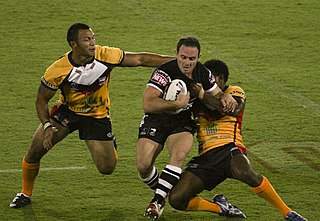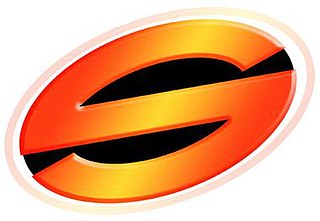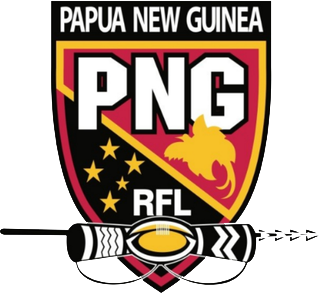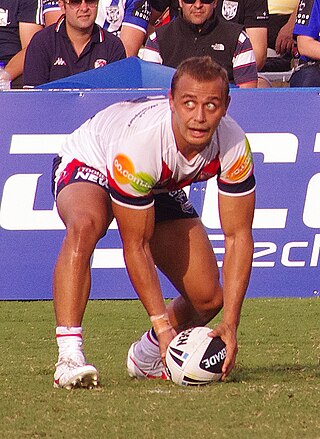| Super League International Board | |
|---|---|
| Founded | 1995 [1] |
| Ceased | 1998 [2] |
| Replaced by | Rugby League International Federation |
| Responsibility | Super League worldwide |
| Key people | Maurice Lindsay [1] (Chair) |
As of 30 November 2009 | |
The Super League International Board was the international governing body for Super League-aligned rugby league football nations between 1995 and 1998.
The Board was formed to administer Super League globally during the Super League war, a corporate dispute fought in and out of court during the mid-1990s by the Rupert Murdoch and News Corporation-backed Super League (Australia) and the Kerry Packer and Optus Vision-backed Australian Rugby League organisations over broadcasting rights for, and ultimately control of the top-level professional rugby league football competition in Australasia. [3] [4] [5]
In December 1995, the Board was formed in Sydney, Australia. [1] Maurice Lindsay, the chief executive of the British Rugby Football League was elected the Board's first chairperson. [1] Lindsay was also the British delegate. [1] John Ribot, the chief executive of Super League (Australia) and a key figure in the Super League project, became Deputy Chairman. [6]
In response to his election, Lindsay shared the thoughts he and Ribot had on the future of the sport under Super League:
Having spent a lifetime in the game and been so heavily involved in international rugby league for so many years, I am very excited. John and I share the same values and belief that our game has been world sport's best kept secret for far too long.
— Maurice Lindsay [1]
The Super League International Board's responsibilities included controlling the laws of the game. [1]
Several new rules had been trialled in Britain and the Board, during its inaugural meeting, decided they should be introduced to other Super League-aligned nations worldwide. [1] [7] The four rule changes related to the play-the-ball, kick-off and scrums. [7]
In 1996, a ruling in the high court meant that Super League would be able to run a domestic competition in Australia the next year. [8] The ruling meant that the Super League International Board was able operate several international competitions, including the 1997 World Club Championship which consisted of 12 European and 10 Australasian sides. [8] The European clubs struggled in the competition and did not perform well financially. [9]
In 1996 and 1997 the Super League World Nines competition was held. Nines rugby league is a faster form of the game with only nine players on the field at a time playing in shorter halves. The World Nines competitions were held as an alternative to the Australian Rugby League's World Sevens. The 1996 World Nines saw a video referee was used for the first time for a game of rugby league.
Under the Super League International Board, competition between national teams was organised. [10] In 1997, Great Britain hosted the Australian Super League test team, losing the series 2–1. [10] The Australian side also played New Zealand. [11] The Rugby Football League and New Zealand Rugby League recognise these matches as having test match status, while the Australian Rugby League has declined to include in its records those of its rival. [11] This actually means that Matt Adamson, Ken Nagas, Paul Green, Craig Greenhill, Solomon Haumono, Julian O'Neill and David Peachey, all of whom only ever represented the Super League version of the Australian team, are listed as never having played a test for Australia in official Australian records.
The creation of the board was expected to weaken the position of the Australian Rugby League, increasing their isolation. [1]
During 1995, more rugby league governing bodies outside Australia, such as France and Papua New Guinea, signed on with Super League, joining Britain and New Zealand. [12] These agreements had the effect of "usurping" the international board's control of the sport and removing international playing opposition for the Australian Rugby League's representative sides. [7] [12] The director-general of the international board was the Australian Rugby League's chairman, Ken Arthurson. [12]
In 1998, the Super League International Board was disestablished and replaced by the Rugby League International Federation (RLIF) as the Super League war ended in Australia and international rugby league reunited. [2] [13] The replacement saw worldwide governance of rugby league handed back to the sport's national governing bodies. [2]
Peace is breaking out all over the world...it was just a matter of getting everyone around the table.
John McDonald, the chair of the Australian Rugby League, became chair of the RLIF. [2] Sir Rodney Walker was elected a member of the RLIF, beating Maurice Lindsay and signifying a power shift in the British game. [2] Walker took the position of vice-chair. [2]
One of the Rugby League International Federation's first tasks upon assuming control was to re-codify the Laws of the Game following the divergence that occurred whilst the game was split. [2]
During their attempts to attract partners, the Super League International Board agreed to give a place in their planned 1998 world cup to the New Zealand Māori rugby league team at a meeting in Paris in 1997. [13] [14] Despite that world cup not taking place, the Rugby League International Federation repeated the offer for the 2000 World Cup and the team competed as "Aotearoa Māori". [13] [14]

Rugby league football, commonly known as just rugby league and sometimes football, footy, rugby or league, is a full-contact sport played by two teams of thirteen players on a rectangular field measuring 68 metres wide and 112–122 metres long with H shaped posts at both ends. It is one of the two codes of rugby football, the other being rugby union. It originated in 1895 in Huddersfield, Yorkshire as the result of a split from the Rugby Football Union over the issue of payments to players. The rules of the game governed by the new Northern Rugby Football Union progressively changed from those of the RFU with the specific aim of producing a faster and more entertaining game to appeal to spectators, on whose income the new organisation and its members depended. Due to its high-velocity contact, cardio-based endurance and minimal use of body protection, rugby league is widely regarded as the toughest and most brutal collision sport in the world.

The 1995 Rugby League World Cup was held during October 1995 in the United Kingdom. It was the eleventh staging of the Rugby League World Cup and was marketed as the Halifax Centenary World Cup, reflecting the tournament's sponsorship and the fact that 1995 marked the centenary of the sport. Envisaged as a celebration of rugby league, the size of the competition was doubled, with four additional teams invited and England and Wales instead of Great Britain national rugby league team.

Super League was an Australian rugby league football administrative body that conducted professional competition in Australia and New Zealand for one season in 1997. Along with Super League of Europe, it was created by News Corporation during the Super League war which arose following an unsuccessful attempt to purchase the pay television rights to rugby league in Australia. After two years of legal battles the competition was played for a single season in 1997 alongside the rival Australian Rugby League (ARL) competition before the two merged in 1998 to form the National Rugby League (NRL).

Jason Thorpe Robinson OBE is an English former dual-code international rugby league and rugby union footballer who played in the 1990s and 2000s. Playing as a wing or fullback, he won 51 rugby union international caps for England and is the first black man to captain the England team. He was part of the 2003 World Cup winning rugby union England team.

The Rugby Football League (RFL) is the governing body for rugby league in England. Founded in 1895 as the Northern Rugby Football Union following 22 clubs resigning from the Rugby Football Union, it changed its name in 1922 to the Rugby Football League.

The Papua New Guinea national rugby league team represents Papua New Guinea in the sport of rugby league football.

The International Rugby League (IRL) is the global governing body for the sport of rugby league football. Previously known as the Rugby League Imperial Board, the International Rugby League Board and latterly the Rugby League International Federation, the IRL is responsible for the Laws of the Game, the development, organisation and governance of rugby leagues internationally, and for the sport's major international tournaments; most notably the Rugby League World Cup.

Rugby league is played across England but is most popular in Northern England, especially Yorkshire and Lancashire where the game originated. These areas are the heartland of rugby league. The sport is also popular in Cumbria where the amateur game is particularly powerful.
John Ribot, also known by the nickname of "Reebs", is an Australian sports administrator, former rugby league footballer of the 1970s and 1980s. Once a Queensland State of Origin and Australian international representative, Ribot was the 1980 NSWRFL season's equal top try-scorer. Also a member of the 1982 "Invincibles" Kangaroo touring squad, he played club football in Brisbane for Fortitude Valley, Wests and Redcliffe, and in Sydney for Newtown, Wests and Manly-Warringah.

The Rugby League World Sevens, usually referred to as the World Sevens and sometimes as the World Cup Sevens, was a pre-season rugby league sevens tournament made up over the years primarily of New South Wales Rugby League (NSWRL), Australian Rugby League (ARL) and mostly recently National Rugby League (NRL) teams, along with teams representing NSW Country and nations including Tonga, France, Papua New Guinea, Samoa, Russia, Fiji, the US and England.
The History of rugby league in South Africa goes back as far as the 1950s. The 1990s brought about the establishment of the South African Rugby Football League to promote amateur rugby league.
Sean "Shoppe" Edward Hoppe is a New Zealand former professional rugby league footballer who represented New Zealand.
Maurice Lindsay was the chairman of Preston North End F.C. and of Wigan Warriors R.L.F.C. and had two stints at the club after being one of the 'Gang of Four' directors that used to run the club when it dominated the league in the 1980s.
Women's rugby league is the female-only version of Rugby league. There are women's clubs in Australia, Great Britain, and New Zealand, overseen internationally by the Women & Girls Rugby League.

The Rugby League World Cup is an international rugby league tournament contested by the top national men's representative teams. The tournament is administered by the International Rugby League and was first held in France in 1954, which was the first World Cup held for any form of rugby football.

Rugby league is a full contact football code and spectator sport played in various countries around the world and governed by the Rugby League International Federation. As of 2010 there are currently 27 nations fielding domestic leagues that meet the World Cup eligibility requirements. Further to this there are over 30 others that are playing at an emerging level status at varying degrees of international competition and are in the process of developing the game in their nations. The global player pool is estimated to be in the millions.
Brian Andrew Jellick is a New Zealand former professional rugby league footballer who played in the 1990s and 2000s. A New Zealand international representative winger, he played his club football in New Zealand, England and Australia.

Hooker is one of the positions in a rugby league football team. Usually wearing jersey or shirt number 9, the hooker is one of the team's forwards. During scrums the hooker plays in the front row, and the position's name comes from their role of 'hooking' or 'raking' the ball back with the foot. For this reason the hooker is sometimes referred to in Australia as the rake.
The Super League war was a commercial competition between the Australian Rugby League (ARL) and the Australian Super League to establish pre-eminence in professional rugby league competition in Australia and New Zealand in the mid-1990s.
The Australia women's national rugby league team, also known as the Australian Jillaroos, or Harvey Norman Jillaroos for sponsorship reasons, represents Australia in women's rugby league. They are administered by the Australian Rugby League Commission and Australian Women's Rugby League.